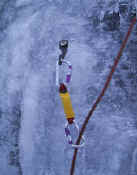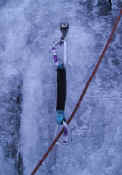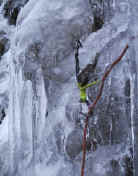


Southern ice climbing tips
Wanna climb some Southern ice? With the short freeze-thaw cycles we get in Dixie, the Southern climber must be willing to tread on some thin ice. With some care you can even protect some of the most marginal climbs.
Well it's time for another disclaimer. The techniques discussed on this page are for educational and entertainment purposes only. Do not read this and attempt to apply to real world conditions without proper instruction. Ice climbing is inherently dangerous and can result in either injury or death. We do not assume any liability for anyone's use of this information.
YATES SCREAMERS
Yates Screamers are vital tools for Southern climbing. The short screamer on the left is my favorite. The center screamer is the standard model. The ice hook one the right is slung with a scream aid.
On the left is a standard Screamer and a shorty. There is no internal difference or performance difference. The short unit just has one more fold and is held tight by industrial heat shrink tubing. Both units reduce the impact on your protection by over 500 pounds. When dealing with marginal placements such a significant reduction in force can be critical. The center photo shows the unit unfolded prior to activation. The photo on the right shows the directional stitching that is designed to dissipate force by tearing when weighted.
The left hand photo shows a close up of a Pika ice hook slung with Scream Aid. The lower activation force of this design makes this marginal piece of pro somewhat trustworthy. The center photo is a Black Diamond Specter that has been slung with a Southern Scream. With this setup you have the option of clipping either through the static loop or the load limiting device. On the right is a Ice Scream. I find these things almost impossible to use with gloves on and do not own but one and it very seldom leaves the house. What I would like to see is a model based on the Scream Aid but with a little more length on both the tie-in loop and the force absorbing stitching.
Under normal conditions you do not tie off a screw unless it protrudes more than two inches from the ice. Constant use of 10 cm screws is not normal though. When there is less than three inches of embedment of screw into the ice then you must do everything possible to reduce leverage. The screamer used here is not commercially available. Yates custom makes these for me. I call it the "Southern Scream". You can easily girth-hitch a screw with one gloved hand using these. I normally use locking biners on my screamers but it is not required with the later generations.
The photo on the left demonstrates how sometimes you have to suck it up and just climb. The screw protrudes so far that clipping the hanger is not an option. The threads on the screw were so sharp I was afraid to put a sling around them. I split the difference and tied it off just above the threads. Sometimes you just do the best you can and hope it slows you down when you fall on it. The best thing to do is not fall and test goofy placements.
The two screamers on the right are from the only ice climbing fall I have ever taken. Even with these I still managed to blow all of my pro on the way down but I firmly believe they reduced enough of the force to allow me to escape severe injury. The blue unit was clipped to a 17cm B-D screw and the red one was on a Specter. Notice all the tacks didn't tear on the screamer clipped to the specter before it pulled out.
I now clip almost every screw on an ice climb with screamers. This in combination with always using double 8.8mm ropes significantly reduces the impact force of a fall on the protection. Here in the South most of the new route development is happening on thinner and thinner ice. It takes a special mindset to climb above marginal protection.
NOTICE THE TIED SICKLE BELOW
THE INSIDE SCOOP DIRECT FROM THE YATES SITE
A PUBLIC LETTER WRITTEN BY JOHN YATES
A CLIMBING MAGAZINE ARTICLE ON SCREAMERS
ice climbing by state
Navigation
ALL OF THE PHOTOS AND TEXT ON THIS SITE IS COPYRIGHTED. NO PORTION MAY BE REPRODUCED WITHOUT EXPRESSED WRITTEN CONSENT.